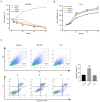STAT3-PTTG11 abrogation inhibits proliferation and induces apoptosis in malignant glioma cells
- PMID: 32774480
- PMCID: PMC7405341
- DOI: 10.3892/ol.2020.11867
STAT3-PTTG11 abrogation inhibits proliferation and induces apoptosis in malignant glioma cells
Abstract
Pituitary tumor transforming gene 1 (PTTG11) is abundantly expressed in glioma. Our previous study demonstrated that the downregulation of PTTG11 gene expression significantly inhibited the proliferation, migration and invasion ability, and increased the apoptosis of SHG44 glioma cells. However, the molecular mechanisms that regulate PTTG11 and its actions remain elusive. In the present study, CCK-8 and flow cytometry assays were used to assess the proliferation/viability and apoptosis, respectively, of the human glioma U251 cell line. STAT3-PTTG1 signals were further evaluated by western blotting. The findings of the present study revealed that STAT3 induced PTTG11 expression, which subsequently induced downstream c-Myc and Bcl-2 expression while inhibiting Bax expression, thereby promoting cell viability and inhibiting apoptosis. PTTG11 suppression via siRNA inhibited the viability and increased the apoptosis of glioma cells induced by the STAT3 activator S3I-201. c-Myc and Bcl-2 expression was suppressed by PTTG11 inhibition. The findings of the present study suggest that the STAT3-PTTG11 signaling pathway may play an important role in glioma progression by regulating cell proliferation and apoptosis.
Keywords: STAT3; apoptosis; malignant glioma; pituitary tumor transforming gene 1; proliferation.
Copyright © 2020, Spandidos Publications.
Figures




Similar articles
-
Inhibition of PTTG1 expression by microRNA suppresses proliferation and induces apoptosis of malignant glioma cells.Oncol Lett. 2016 Nov;12(5):3463-3471. doi: 10.3892/ol.2016.5035. Epub 2016 Aug 22. Oncol Lett. 2016. PMID: 27900021 Free PMC article.
-
Knockdown long non-coding RNA PEG10 inhibits proliferation, migration and invasion of glioma cell line U251 by regulating miR-506.Gen Physiol Biophys. 2019 Jul;38(4):295-304. doi: 10.4149/gpb_2019018. Epub 2019 Jun 26. Gen Physiol Biophys. 2019. PMID: 31241046
-
Allicin Inhibits Proliferation and Invasion in Vitro and in Vivo via SHP-1-Mediated STAT3 Signaling in Cholangiocarcinoma.Cell Physiol Biochem. 2018;47(2):641-653. doi: 10.1159/000490019. Epub 2018 May 22. Cell Physiol Biochem. 2018. PMID: 29794468
-
Histone acetyltransferase inhibitor II induces apoptosis in glioma cell lines via the p53 signaling pathway.J Exp Clin Cancer Res. 2014 Dec 19;33(1):108. doi: 10.1186/s13046-014-0108-3. J Exp Clin Cancer Res. 2014. PMID: 25523932 Free PMC article.
-
[Silencing of carcinoembryonic antigen-related cell adhesion molecule 1 inhibits proliferation and induces apoptosis in human glioma SHG44 cells].Xi Bao Yu Fen Zi Mian Yi Xue Za Zhi. 2015 Jan;31(1):23-6, 31. Xi Bao Yu Fen Zi Mian Yi Xue Za Zhi. 2015. PMID: 25575053 Chinese.
Cited by
-
Co-expression of immune checkpoints in glioblastoma revealed by single-nucleus RNA sequencing and spatial transcriptomics.Comput Struct Biotechnol J. 2024 Apr 10;23:1534-1546. doi: 10.1016/j.csbj.2024.04.014. eCollection 2024 Dec. Comput Struct Biotechnol J. 2024. PMID: 38633388 Free PMC article.
References
-
- Louis DN, Perry A, Reifenberger G, von Deimling A, Branger DF, Cavenee WK, Ohgaki H, Wiestler OD, Kleihues P, Ellison DW. The 2016 world health organization classification of tumors of the central nervous system: A summary. Acta Neuropathol. 2016;131:803–820. doi: 10.1007/s00401-016-1545-1. - DOI - PubMed
-
- Navarro L, Gil-Benso R, Megías J, Muñoz-Hidalgo L, San- Miguel T, Callaghan RC, González-Darder JM, López-Ginés C, Cerdá-Nicolás MJ. Alteration of major vault protein in human glioblastoma and its relation with EGFR and PTEN status. Neuroscience. 2015;297:243–251. doi: 10.1016/j.neuroscience.2015.04.005. - DOI - PubMed
LinkOut - more resources
Full Text Sources
Research Materials
Miscellaneous
